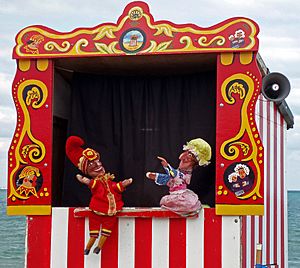Low comedy facts for kids
Low comedy, also called lowbrow humor, is a type of comedy that mainly aims to make people laugh. It often involves silly actions, funny boasts, and playful chaos. Think of things like "horseplay," slapstick (like someone slipping on a banana peel), or farce (a play full of ridiculous situations). A classic example is someone getting a custard pie thrown in their face!
The name "low comedy" was first used by a writer named John Dryden. He mentioned it in the introduction to his play An Evening's Love.
Contents
The History of Low Comedy
This type of comedy has been around for a very long time, even since the days of ancient Greek plays. For example, the Greek writer Sophocles once wrote a play where silly characters tried to convince a king they were good husbands for his daughter by bragging in a funny way. Another Greek playwright, Aristophanes, wanted his plays to be understood by everyone, not just highly educated people. The word 'comedy' itself comes from a Greek phrase that might mean "Song of Revelry" or "Song of The Village," suggesting it was for everyone in the community.
From Streets to Screens
At first, low comedy was often performed by street entertainers. They would put on shows for common people. Over time, this style of comedy became more popular and was used by many different performers. You can see it in stand-up comedians' acts and even in musicals.
Low comedy also became a big part of early cartoons. For instance, in Porky's Duck Hunt, Porky Pig often gets into funny physical mishaps. In a 1945 Bugs Bunny cartoon, Bugs plays tricks on a silly character, making his pants fall down. Also, Daffy Duck is often comically shot by Elmer Fudd in the "Wabbit Season" cartoons. These are all examples of low comedy in action.
Low Comedy in Our World
Low comedy is very common in society today. You can find it in many types of mass media, like television shows and theatre performances. It's also part of jobs like clowns, mimes, and comedians. The word low here connects to "low culture," which means things that are popular and easy for everyone to understand, no matter their education level.
Why It's Popular
Low comedy is well-known and popular because it's considered suitable for almost everyone. Its simple and easy-to-understand style makes it connect well with popular culture. It doesn't require a lot of background knowledge to "get" the jokes.
However, low comedy sometimes doesn't get as much respect as "high comedy." High comedy often has deeper messages or clever wordplay. The main goal of low comedy is simply to make people laugh. Because it usually doesn't have a hidden message, some people don't value it as much. But this doesn't stop it from being a very effective way to bring laughter!
Changing Ideas of Comedy
What people consider "low comedy" can change over time. As society changes, so do our ideas about what is "high" or "low" comedy. For example, some sitcoms (situation comedies) might be seen as low comedy if they rely too much on constant insults or silly arguments.
Some shows mix both styles. For instance, the cartoon series The Simpsons often uses slapstick humor, like characters getting hurt in funny ways. But it also makes fun of political issues and cleverly references classic movies and books. This shows how comedy can sometimes blend different styles.
Today, you can find low comedy in almost any type of entertainment. Sitcoms often use it as a main part of their stories because it's so popular. Even modern versions of Shakespeare's plays sometimes add low comedy to make them more relatable and funny for today's audiences. For example, in As You Like It, there's a funny mix-up where a woman disguised as a man accidentally makes another woman fall in love with her.
See also
- Flatulence humor
- High comedy
- The Three Stooges, three famous comedians known for their slapstick humor. They were often called "the high priests of low comedy."


